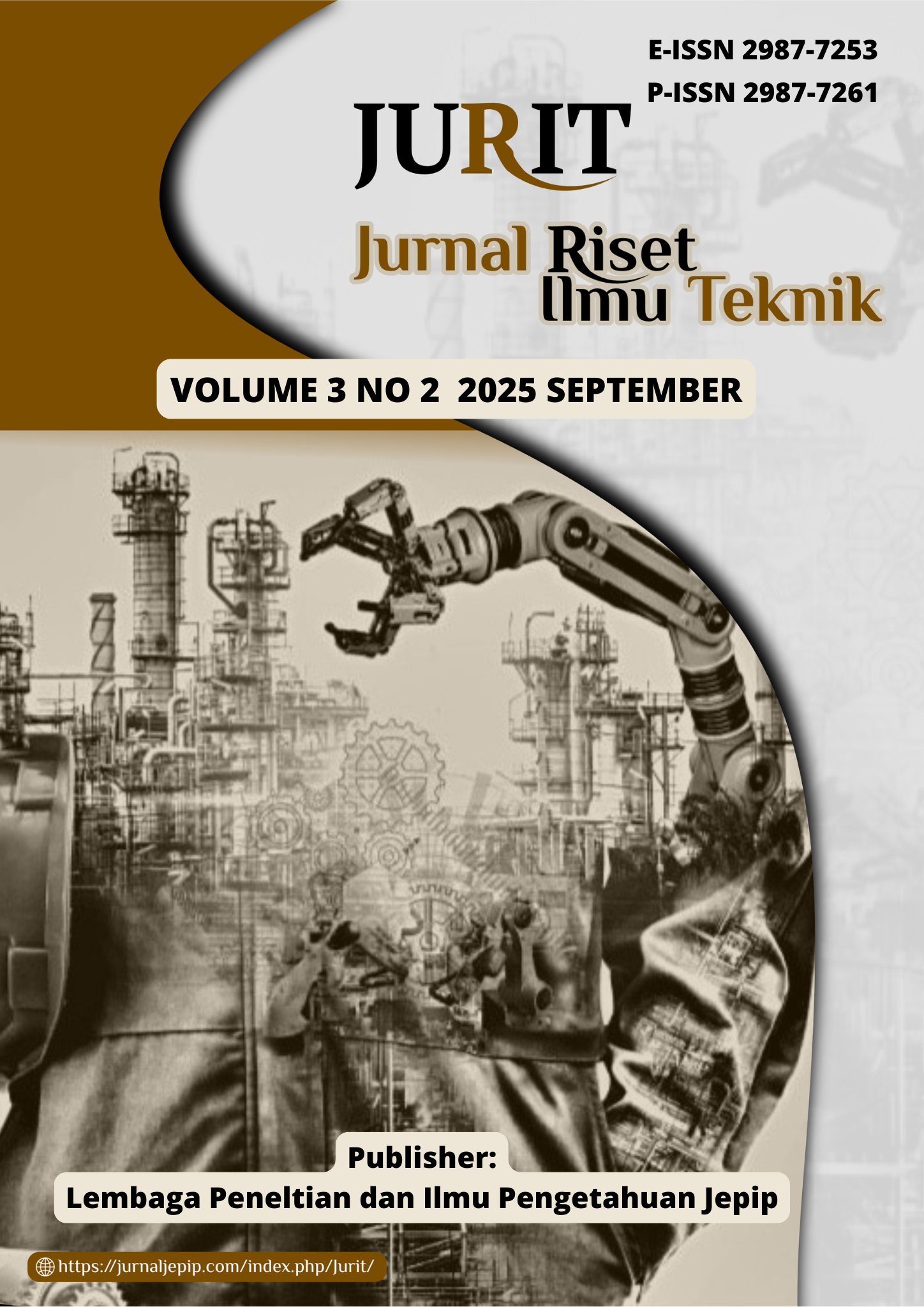Hybrid Fuzzy–Eckenrode Model for Quantitative Evaluation of Fermented Cocoa Bean Quality in Ivory Coast
DOI:
https://doi.org/10.59976/jurit.v3i2.200Abstract
This study aims to develop a quantitative decision-support model for assessing the quality of fermented cocoa beans in Ivory Coast, addressing the persistent inconsistency in cocoa bean quality that undermines international competitiveness. Despite being the world’s largest cocoa producer, Ivory Coast experiences frequent quality downgrades due to weak fermentation control and limited data-driven evaluation frameworks. A descriptive–analytical quantitative approach was employed, integrating the Eckenrode and Fuzzy Eckenrode methods to transform expert judgment into measurable weights for key cocoa quality attributes—namely fat content, acidity (pH), moisture, aroma, and bitterness. Field data were collected from three major cocoa-producing regions (Yamoussoukro, Daloa, and San-Pédro) through expert evaluations and sensory analyses. The hybrid fuzzy logic model was used to enhance precision in ranking attribute importance under uncertain assessments. Results revealed that fat content (0.103), pH acidity (0.092–0.106), and moisture content (0.078–0.089) are the most influential quality determinants. Cocoa Type C exhibited the most balanced fermentation and post-harvest consistency, achieving a total attribute dispersion (ΣB = 0.139) that aligns with premium-grade standards. The fuzzy hybrid model successfully reduced subjective variability and improved ranking stability compared to classical MCDM methods. This study pioneers the application of Fuzzy Eckenrode in cocoa quality evaluation within the African agroindustrial context. By linking physicochemical and sensory parameters through quantitative weighting, it provides a replicable decision-support tool that bridges traditional post-harvest practices with data-driven quality management for sustainable cocoa competitiveness in Ivory Coast.
Downloads
References
R. Pholsin, “Impact of pectin edible coating extracted from cacao shell powder on postharvest quality attributes of tomato (Lycopersicon esculentum Mill.) fruit during storage,” Food Control, vol. 155, 2024, doi: 10.1016/j.foodcont.2023.110023.
E. Subroto, “Microbiological Activity Affects Post-Harvest Quality of Cocoa (Theobroma cacao L.) Beans,” 2023. doi: 10.3390/horticulturae9070805.
D. Pérez-Neira, “Sustainability of food security in different cacao production systems: A land, labour, energy and food quality nexus approach,” Resour. Conserv. Recycl., vol. 190, 2023, doi: 10.1016/j.resconrec.2023.106874.
S. Streule, “Effect of Pod Storage and Drying Temperature on Fermentation Dynamics and Final Bean Quality of Cacao Nacional in Ecuador,” Foods, vol. 13, no. 10, 2024, doi: 10.3390/foods13101536.
B. Hirko, “Role of fermentation and microbes in cacao fermentation and their impact on cacao quality,” 2023. doi: 10.1007/s43393-023-00160-9.
J. Vansynghel, “Cross-pollination with native genotypes improves fruit set and yield quality of Peruvian cacao,” Agric. Ecosyst. Environ., vol. 357, 2023, doi: 10.1016/j.agee.2023.108671.
I. Morales-Belpaire, “Soil quality indicators under five different cacao production systems and fallow in Alto Beni, Bolivia,” Agrofor. Syst., vol. 98, no. 7, pp. 2517–2532, 2024, doi: 10.1007/s10457-024-01048-w.
M. S. Araújo, “Multi-trait selection for nutritional and physiological quality of cacao genotypes in irrigated and non-irrigated environments,” Sci. Rep., vol. 14, no. 1, 2024, doi: 10.1038/s41598-024-56556-7.
M. C. Alvarado, “Emerging rapid and non-destructive techniques for quality and safety evaluation of cacao: recent advances, challenges, and future trends,” 2023. doi: 10.1186/s43014-023-00157-w.
R. Arulmari, “Effect of Fermentation Methods and Turning Interval on the Quality of Cocoa Beans (Theobroma cacao),” Agric. Res., vol. 13, no. 3, pp. 586–598, 2024, doi: 10.1007/s40003-024-00715-9.
A. Pérez-Díaz, “Quality indicators for micrografted seedlings of Theobroma cacao inoculated with arbuscular mycorrhizal fungi,” Agron. Mesoam., vol. 34, no. 2, 2023, doi: 10.15517/am.v34i2.51102.
L. F. Quintana-Fuentes, “Impact of Spontaneous Fermentation on the Physicochemical and Sensory Qualities of Cacao,” 2025. doi: 10.3390/fermentation11070377.
D. Yang, “Quality differences and profiling of volatile components between fermented and unfermented cocoa seeds (Theobroma cacao L.) of Criollo, Forastero and Trinitario in China,” Beverage Plant Res., vol. 4, 2024, doi: 10.48130/bpr-0024-0002.
F. I. Flor, “Post-harvest quality of cacao (Theobroma cacao L.) for the chocolate industry,” 2024. doi: 10.4324/9781003381761-17.
A. Muppayyanamath, “Quality by design-based optimization and HP-TLC densitometric standardization of Theobroma cacao L. extract as a nutraceutical supplement,” Front. Nutr., vol. 12, 2025, doi: 10.3389/fnut.2025.1537963.
I. Quintero, “Dry cacao pulp in chocolate bars: A sustainable, nutrient-rich sweetener with enhanced sensory quality through refractance windows drying,” Appl. Food Res., vol. 5, no. 1, 2025, doi: 10.1016/j.afres.2025.100700.
R. N. Raju, “Influence of fermentation on the quality of Fijian Theobroma cacao beans over two harvest seasons,” New Zeal. J. Crop Hortic. Sci., vol. 52, no. 4, pp. 441–454, 2024, doi: 10.1080/01140671.2024.2355965.
V. L. Nguyen, “Valorization of cocoa (Theobroma cacao L.) pod husks as a fruit pulp substitute in mango jam formulations: effects on jam qualities during storage and sensory discrimination†,” Sustain. Food Technol., vol. 3, no. 1, pp. 333–342, 2024, doi: 10.1039/d4fb00331d.
N. M. d. J. Silva, “Exploring variations in quality parameters of Theobroma cacao L.beans from Eastern Amazonia,” Heliyon, vol. 10, no. 21, 2024, doi: 10.1016/j.heliyon.2024.e39295.
J. C. Nuñez, “Effect of microencapsulated inoculum of Pichia kudriavzevii on the fermentation and sensory quality of cacao CCN51 genotype,” J. Sci. Food Agric., vol. 103, no. 5, pp. 2425–2435, 2023, doi: 10.1002/jsfa.12433.
L. Haruna, “Effects of Predrying and Spontaneous Fermentation Treatments on Nib Acidification, Fermentation Quality, and Flavour Attributes of Ghanaian Cocoa (Theobroma cacao) Beans,” Int. J. Food Sci., vol. 2024, 2024, doi: 10.1155/2024/5198607.
J. A. Oñate-Gutiérrez, “Exploring the chemical composition and coloring qualities of cacao fruit epicarp extracts,” Rsc Adv., vol. 13, no. 19, pp. 12712–12722, 2023, doi: 10.1039/d3ra01049j.
S. Irawan, “Evaluation of soil quality index in different types of land use for Theobroma cacao L. development in Kebonagung subdistrict, Pacitan district,” Bulg. J. Agric. Sci., vol. 29, no. 5, pp. 805–812, 2023, [Online]. Available: https://www.scopus.com/inward/record.uri?partnerID=HzOxMe3b&scp=85175254545&origin=inward
B. Parlatır, “Use of locust bean flour as a substitute for cocoa in the production of chocolate spread: Quality attributes and storage stability,” Grasas Y Aceites, vol. 75, no. 2, 2024, doi: 10.3989/gya.0647231.
J. O. Eduah, “Differential impacts of organic and chemical fertilization on soil organic carbon pools and stability, and soil quality in cacao agroforestry,” Soil Environ. Heal., vol. 3, no. 3, 2025, doi: 10.1016/j.seh.2025.100147.
J. S. Kim, “Quality characteristics and antioxidant activity of meringue Jeung-pyun with different amounts of cacao bean husk,” Food Sci. Biotechnol., vol. 33, no. 4, pp. 817–829, 2024, doi: 10.1007/s10068-023-01404-z.
L. S. Freitas, “Elite Cacao Clonal Cultivars with Diverse Genetic Structure, High Potential of Production, and Good Organoleptic Quality Are Helping to Rebuild the Cocoa Industry in Brazil,” Int. J. Mol. Sci., vol. 26, no. 7, 2025, doi: 10.3390/ijms26073386.
M. Hamawi, “Significant potential of tape yeast and plant leaves as a cover for fermented cocoa (Theobroma cacao L.) beans to generate qualities of dry cocoa beans,” Food Res., vol. 8, pp. 66–77, 2024, doi: 10.26656/fr.2017.8(S2).50.
V. Jegadeeswari, “Standardization of micronutrient dosage to improve yield and quality of cocoa (Theobroma cacao L.) grown under coconut ecosystem in Tamil Nadu,” J. Plant. Crop., vol. 52, no. 1, pp. 21–27, 2024, doi: 10.25081/jpc.2024.v52.i1.9172.
G. R. F. Cuzzuol, “The C assimilation, fruit dimensions, and chemical quality of Theobroma cacao almonds of PH 16 and ‘Ipiranga’ 01 genotypes cultivated in full sun are better than in the shade,” Sci. Hortic. (Amsterdam)., vol. 308, 2023, doi: 10.1016/j.scienta.2022.111566.
D. Alegría-Campo, “Evaluation of the productivity quality of the cocoa bean according to the Theory of Practice (TP) and Artificial Intelligence: a systematic review,” Dyna Colomb., vol. 90, no. 225, pp. 71–76, 2023, doi: 10.15446/dyna.v90n225.103832.
J. Haro, “Evaluation of Soil Quality and Health Sustainability of Cocoa (Theobroma Cacao) Crop in Two Production Systems, Morona, Santiago, Ecuador,” J. Environ. Earth Sci., vol. 7, no. 1, pp. 306–320, 2025, doi: 10.30564/jees.v7i1.7600.
I. Saputra, “Optimization of Biochar Quality from Palm and Cacao Waste through Variation of Pyrolysis Temperature and Duration as a Soil Amendment Material,” Online J. Biol. Sci., vol. 24, no. 4, pp. 765–776, 2024, doi: 10.3844/ojbsci.2024.765.776.
I. K. Fitri, “Seed coating formula made from plant-based fungicide to maintain the quality of cocoa seeds ( Theobroma cacao L.),” 2024. doi: 10.1088/1755-1315/1386/1/012008.
L. D. Becerra, “Microstructural characterization of cacao seeds during controlled transformation through microscopy techniques and image analysis: Insights into quality-related attributes,” Plant Physiol. Biochem., vol. 223, 2025, doi: 10.1016/j.plaphy.2025.109899.
M. Santander, “Influence of driven fermentation of cacao in bioreactors on quality: decoding the effect of temperature, mixing, and pH on metabolomic, sensory, and volatile profiles,” Lwt, vol. 231, 2025, doi: 10.1016/j.lwt.2025.118313.
J. R. Saguidon, “Internet-of- Things (IoT) - Based Automated Temperature Monitoring and Control System for Enhanced Cacao Fermentation Quality,” 2024. doi: 10.1109/ICECIE63774.2024.10815649.
P. Díaz-Chuquizuta, “Bioferments in the morphological and quality of cocoa (Theobroma cacao L.) seedlings in the nursery,” Trop. Subtrop. Agroecosystems, vol. 28, no. 3, 2025, doi: 10.56369/tsaes.6271.
Z. Papalexandratou, “Cacao post-harvest processing: From tradition to modernization and its role to quality diversification,” 2024. doi: 10.4324/9781003381761-14.
K. A. Konan, “Impact of New Fermentation Supports on the Quality of Cocoa Beans (Theobroma cacao L.) From Côte d’Ivoire,” J. Food Qual., vol. 2025, no. 1, 2025, doi: 10.1155/jfq/2118517.
Downloads
Published
How to Cite
Issue
Section
License
Copyright (c) 2025 Koffi Ahua René, Wim Pelupessy

This work is licensed under a Creative Commons Attribution 4.0 International License.

















